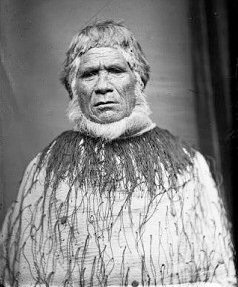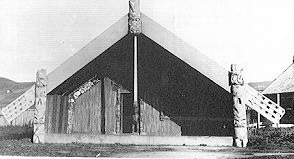Te Hapuku

Marie Te Hapuku
Te Hapuku Ngai Te Whatuiapiti c.1797 - 1878
Paramount Chief of Hawkes Bay

He was the chief of his Ngai Te Whatuiapiti tribe and his main hapu (sub tribes) were Ngati Te Manawakawa and Ngati Rangikoianake. He had kinship links within Ngati Kahungunu, Rangitane, Ngati Ira and other tribes throughout the Hawke's Bay and Wairarapa regions, and was therefore very influential. His father was Kurimate, also known as Te Rangikoianake II, and his mother was Tatari of the Ngati Tapuhara and Ngati Hinepare sub tribes of Ngati Kahungunu.
With the coming of the Pakeha government to his region in 1851 Te Hapuku established contact with many government officials and was instrumental in selling lands to the government. He was acquainted with both Donald McLean, the chief land purchase agent, and with the Governor, Sir George Grey. He used the proceeds of his land sales to establish farming, milling, shipping and other businesses to support his large tribe.
He was also the prime instigator of a gift of lands by his tribe to Christian missionaries for the establishment of a school to educate Maori pupils. Te Aute College was established in 1854. Although he himself rejected Christianity, he allowed missionaries to continue to teach his whaanau.

In 1876, in response to an ancient prophecy, Te Hapuku built the house Kahuranaki at Kahuranaki Marae at his village of Te Hauke. That house was burnt down in 1913 and was replaced by the present carved and embellished meeting house, also called Kahuranaki. After the accidental burning of the first Kahuranki some people jokingly referred to the tribe as Ngati Hikareti (the Cigarette tribe).
Te Hapuku died on 23 May 1878 at Te Hauke. As he lay dying he asked to be placed so that his eyes should close watching his sacred Kahuranaki mountain. His funeral was attended by 400 Maori and Pakeha; the service was conducted by Samuel Williams. He was buried in a vault, 12 feet deep, 200 feet from the pa.
ANGELA BALLARA
Extract based on biography found at Dictionary of New Zealand Biography website. Ballara, Angela. 'Te Hapuku ? - 1878'. Dictionary of New Zealand Biography, updated 4 April 2003 URL: http://www.dnzb.govt.nz. The original version of this biography was published in the Dictionary of New Zealand Biography Volume One (1769-1869), 1990 © Crown Copyright 1990-2003. Published by the Ministry for Culture and Heritage, Wellington, New Zealand. Reprinted with permission. All rights reserved.